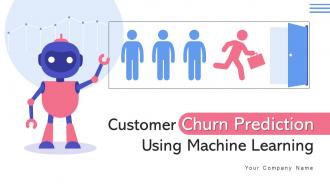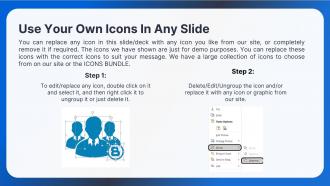Customer Churn Prediction Using Machine Learning Powerpoint Presentation Slides ML CD
Check out our professionally designed Customer Churn Prediction Using Machine Learning PowerPoint. This Customer Retention PowerPoint presentation introduces the concept of estimating customer churn using machine learning. Moreover, the PPT deck includes the steps involved in the customer churn prediction process using ml, such as defining the problem and goal for churn prediction. Lastly, this presentation includes the retention strategies to reduce customer churn, the impact of implementing ml for churn prediction, and the dashboard for customer churn analysis. To learn more about customer churn prediction using ML, download our 100 percent editable and customizable template, also compatible with Google Slides.
You must be logged in to download this presentation.
PowerPoint presentation slides
While your presentation may contain top-notch content, if it lacks visual appeal, you are not fully engaging your audience. Introducing our Customer Churn Prediction Using Machine Learning Powerpoint Presentation Slides ML CD deck, designed to engage your audience. Our complete deck boasts a seamless blend of Creativity and versatility. You can effortlessly customize elements and color schemes to align with your brand identity. Save precious time with our pre-designed template, compatible with Microsoft versions and Google Slides. Plus, it is downloadable in multiple formats like JPG, JPEG, and PNG. Elevate your presentations and outshine your competitors effortlessly with our visually stunning 100 percent editable deck.
People who downloaded this PowerPoint presentation also viewed the following :
Content of this Powerpoint Presentation
Slide 1: The slide introduces Customer Churn Prediction Using Machine Learning. State Your Company name and begin.
Slide 2: This is an Agenda slide. State your agendas here.
Slide 3: The slide displays Table of contents for the presentation.
Slide 4: The slide renders Table of contents further.
Slide 5: This slide demonstrates the graphical representation of the increasing user customer churn rate.
Slide 6: This slide covers the company’s underperforming metrics, such as customer satisfaction score, net promoter score, average revenue per user, etc.
Slide 7: This slide highlights key problems faced by the company due to rising user churn, such as declining revenue, increased marketing costs, etc.
Slide 8: The slide again shows Title of contents.
Slide 9: This slide covers the major reasons for implementing customer churn prediction using machine learning.
Slide 10: The slide shows another Title of contents.
Slide 11: This slide contains a brief overview of machine learning for making predictions without explicit programming.
Slide 12: This slide highlights key advantages of machine learning for churn prediction such as identify at-risk customers, optimize products and services, etc.
Slide 13: The slide renders another Title of contents.
Slide 14: This slide covers major steps for churn prediction, such as defining the problem, explanatory data analysis, data cleaning, preprocessing, etc.
Slide 15: The slide represents Title of contents further.
Slide 16: This slide contains the process of defining the timeframe and the business context for customer churn prediction.
Slide 17: The slide depicts Title of contents further.
Slide 18: This slide contains a brief defines classification as the process of categorizing a given set of data into classes.
Slide 19: This slide briefly defines regression in machine learning.
Slide 20: This slide covers key parameters to consider before selecting an ML algorithm, such as the nature of the problem, size and complexity, etc.
Slide 21: This slide highlights approaches for customer churn prediction, such as classification and regression.
Slide 22: The slide displays Title of contents further.
Slide 23: This slide provides a brief introduction to data collection in machine learning.
Slide 24: This slide contains key machine learning trends for data gathering such as synthetic data generation, active learning, transfer learning, etc.
Slide 25: This slide displays major data-gathering technologies for machine learning such as web scraping, application programming interfaces (APIs), etc.
Slide 26: This slide covers major data collection sources for user attrition rate forecasts.
Slide 27: The slide depicts Title of contents further.
Slide 28: This slide provides a brief introduction to exploratory data analysis in machine learning.
Slide 29: This slide covers elements of exploratory data analysis for churn prediction.
Slide 30: The slide again shows Title of contents.
Slide 31: This slide covers the need for data preprocessing in machine learning, such as improving data quality, dealing with missing values, normalizing and scaling.
Slide 32: This slide highlights the process of data preprocessing in machine learning.
Slide 33: This slide contains major data integration challenges faced during user churn forecasts.
Slide 34: The slide shows Title of contents further.
Slide 35: This slide covers a brief introduction to feature engineering in ML.
Slide 36: This slide contains the feature engineering steps in machine learning.
Slide 37: This slide highlights key feature engineering tactics such as one-hot encoding, binning, scaling, feature split, and text data preprocessing.
Slide 38: This slide covers the major features for churn prediction, such as customer characteristics, product characteristics, transaction history, etc.
Slide 39: This slide renders key ways for determining features during churn prediction such as Permutation Importance, ELI5 Python Package, and SHAP.
Slide 40: The slide shows another Title of contents.
Slide 41: This slide covers a brief introduction to a non-parametric supervised learning algorithm.
Slide 42: This slide contains the process flow of customer churn prediction using the decision tree algorithm.
Slide 43: The slide again displays Title of contents.
Slide 44: This slide covers a brief overview of logistic regression analysis.
Slide 45: This slide renders assumptions for churn prediction related to the binary-dependent variable, independence, no multicollinearity, linearity, and sample size.
Slide 46: The slide shows Title of contents which is to be discussed further.
Slide 47: This slide gives a brief introduction to random forest algorithms.
Slide 48: This slide contains the random forest model creation steps, such as creating dummy variables, creating datasets with predictor variables, etc.
Slide 49: The slide again shows Title of contents.
Slide 50: This slide covers key elements to consider for churn prediction such as complexity of issue, data availability & quality, interpretability, etc.
Slide 51: This slide renders methods of choosing the right churn prediction model, such as train-test split, cross-validation, model averaging, and model performance.
Slide 52: The slide illustrates Title of contents further.
Slide 53: This slide covers various elements of model training for churn prediction such as feeding engineered data, parametrized ML algorithm, etc.
Slide 54: The slide displays another Title of contents.
Slide 55: This slide covers major methods of machine learning model optimization, such as exhaustive search, gradient descent, and genetics.
Slide 56: The slide depicts Title of contents which is to be discussed further.
Slide 57: This slide gives a brief introduction to hyperparameters and hyperparameter tuning.
Slide 58: This slide covers methods of hyperparameter tuning such as grid search, random search, and Bayesian optimization.
Slide 59: The slide renders Title of contents further.
Slide 60: This slide covers machine learning model implementation methods such as API deployment, batch deployment, and model export.
Slide 61: The slide again represents Title of contents.
Slide 62: This slide covers significant business processes for integrating prediction models such as CRM systems, marketing automation platforms, etc.
Slide 63: The slide continues Title of contents.
Slide 64: This slide covers elements such as model performance monitoring, data quality and distribution, model retraining and updates, etc.
Slide 65: The slide shows another Title of contents.
Slide 66: This slide covers customer retention strategies based on machine learning outcomes.
Slide 67: The slide again represents Ttitel of contents.
Slide 68: This slide highlights the graphical representation of the decreasing user customer churn rate.
Slide 69: This slide covers improved company metrics, such as customer satisfaction score, net promoter score, average revenue per user, customer lifetime value, etc.
Slide 70: The slide illustrates Title of contents.
Slide 71: This slide covers a dashboard for evaluating customer churn metrics such as subscribers churning, revenue lost, and churn-to-retention proportion, etc.
Slide 72: This slide shows all the icons included in the presentation.
Slide 73: This slide is titled as Additional Slides for moving forward.
Slide 74: The slide describes Major reasons for customer churn across various sectors.
Slide 75: The sldie displays Major types of customer churn.
Slide 76: This slide covers machine learning applications across telecom, retail, banking, and marketing.
Slide 77: The slide shows the Difference between regression and classification in ML.
Slide 78: This is our mission, vision and goal slide. State your firm's goal here.
Slide 79: This is Our Team slide with names and designation.
Slide 80: This is an Idea Generation slide to state a new idea or highlight information, specifications etc.
Slide 81: This slide describes Line chart with two products comparison.
Slide 82: This slide presents Roadmap with additional textboxes.
Slide 83: This is a Thank You slide with address, contact numbers and email address.
Customer Churn Prediction Using Machine Learning Powerpoint Presentation Slides ML CD with all 92 slides:
Use our Customer Churn Prediction Using Machine Learning Powerpoint Presentation Slides ML CD to effectively help you save your valuable time. They are readymade to fit into any presentation structure.
-
“As you have innovative ideas and they are all customizable, this saves a huge chunk of your time to prepare well-read presentations.”
-
Professional and unique presentations.































































































































































































